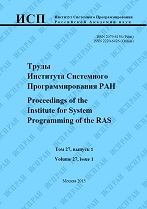|
This article is cited in 2 scientific papers (total in 2 papers)
Occlusion culling algorithm based on software visibility checks
V. I. Gonakhchyan
Ivannikov Institute for System Programming of the RAS
Abstract:
Rendering of 3D scenes with big number of objects is computationally intensive. Occlusion culling methods are used to decrease the number of handled objects. We consider interactive occlusion culling methods that have spatial and time coherence. We propose algorithm to increase rendering performance by using occlusion checks implemented in software mode. We propose heuristic to determine hierarchy level that corresponds to the most efficient occlusion checking. The algorithm is compared with the algorithm based on hardware occlusion queries. Checking for occlusion on CPU avoids transmission overhead between CPU and GPU and as a result improves rendering performance of 3d scenes with big number of objects. Section 1 provides an overview of related work as well as general purposes of given paper and its structure. Section 2 describes the basic formulas that are used in software rasterization and visibility checks. Section 3 describes the proposed algorithm for removing invisible surfaces. Section 4 presents the results of comparing the performance of the proposed algorithm and the algorithm based on hardware visibility requests. Section 5 summarizes the main conclusions.
Keywords:
3d rendering, occlusion query, octree.
Citation:
V. I. Gonakhchyan, “Occlusion culling algorithm based on software visibility checks”, Proceedings of ISP RAS, 30:2 (2018), 81–98
Linking options:
https://www.mathnet.ru/eng/tisp310 https://www.mathnet.ru/eng/tisp/v30/i2/p81
|

| Statistics & downloads: |
| Abstract page: | 400 | | Full-text PDF : | 338 | | References: | 45 |
|




 Contact us:
Contact us: Terms of Use
Terms of Use
 Registration to the website
Registration to the website Logotypes
Logotypes








 Citation in format
Citation in format 
